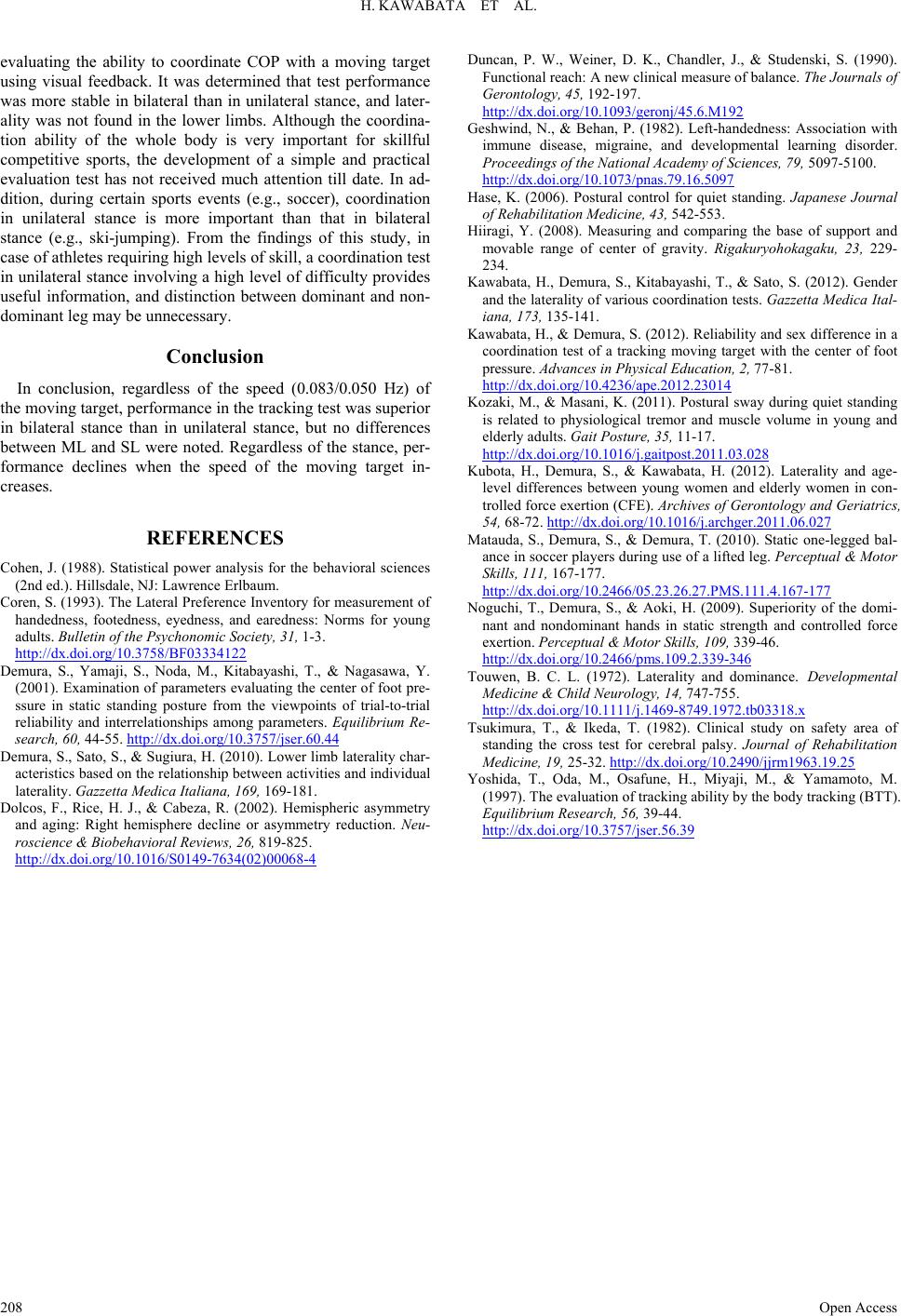
H. KAWABATA ET AL.
evaluating the ability to coordinate COP with a moving target
using visual feedback. It was determined that test performance
was more stable in bilateral than in unilateral stance, and later-
ality was not found in the lower limbs. Although the coordina-
tion ability of the whole body is very important for skillful
competitive sports, the development of a simple and practical
evaluation test has not received much attention till date. In ad-
dition, during certain sports events (e.g., soccer), coordination
in unilateral stance is more important than that in bilateral
stance (e.g., ski-jumping). From the findings of this study, in
case of athletes requiring high levels of skill, a coordination test
in unilateral stance involving a high level of difficulty provides
useful information, and distinction between dominant and non-
dominant leg may be unnecessary.
Conclusion
In conclusion, regardless of the speed (0.083/0.050 Hz) of
the moving target, performance in the tracking test was superior
in bilateral stance than in unilateral stance, but no differences
between ML and SL were noted. Regardless of the stance, per-
formance declines when the speed of the moving target in-
creases.
REFERENCES
Cohen, J. (1988). Statistical power analysis for the behavioral sciences
(2nd ed.). Hillsdale, NJ: Lawrence Erlbaum.
Coren, S. (1993). The Lateral Preference Inventory for measurement of
handedness, footedness, eyedness, and earedness: Norms for young
adults. Bulletin of the Psychonomic Society, 31, 1-3.
http://dx.doi.org/10.3758/BF03334122
Demura, S., Yamaji, S., Noda, M., Kitabayashi, T., & Nagasawa, Y.
(2001). Examination of parameters evaluating the center of foot pre-
ssure in static standing posture from the viewpoints of trial-to-trial
reliability and interrelationships among parameters. Equilibrium Re-
search, 60, 44-55. http://dx.doi.org/10.3757/jser.60.44
Demura, S., Sato, S., & Sugiura, H. (2010). Lower limb laterality char-
acteristics based on the relationship between activities and individual
laterality. Gazzetta Medica Italiana, 169, 169-181.
Dolcos, F., Rice, H. J., & Cabeza, R. (2002). Hemispheric asymmetry
and aging: Right hemisphere decline or asymmetry reduction. Neu-
roscience & Biobehavioral Reviews, 26, 819-825.
http://dx.doi.org/10.1016/S0149-7634(02)00068-4
Duncan, P. W., Weiner, D. K., Chandler, J., & Studenski, S. (1990).
Functional reach: A new clinical measure of balance. The Journals of
Gerontology, 45, 192-197.
http://dx.doi.org/10.1093/geronj/45.6.M192
Geshwind, N., & Behan, P. (1982). Left-handedness: Association with
immune disease, migraine, and developmental learning disorder.
Proceedings of the National Academy of Sciences, 79, 5097-5100.
http://dx.doi.org/10.1073/pnas.79.16.5097
Hase, K. (2006). Postural control for quiet standing. Japanese Journal
of Rehabilitation Medicine, 43, 542-553.
Hiiragi, Y. (2008). Measuring and comparing the base of support and
movable range of center of gravity. Rigakuryohokagaku, 23, 229-
234.
Kawabata, H., Demura, S., Kitabayashi, T., & Sato, S. (2012). Gender
and the laterality of various coordination tests. Gazzetta Medica Ital-
iana, 173, 135-141.
Kawabata, H., & Demura, S. (2012). Reliability and sex difference in a
coordination test of a tracking moving target with the center of foot
pressure. Advances in Physical Education, 2, 77-81.
http://dx.doi.org/10.4236/ape.2012.23014
Kozaki, M., & Masani, K. (2011). Postural sway during quiet standing
is related to physiological tremor and muscle volume in young and
elderly adults. Gait Posture, 35, 11-17.
http://dx.doi.org/10.1016/j.gaitpost.2011.03.028
Kubota, H., Demura, S., & Kawabata, H. (2012). Laterality and age-
level differences between young women and elderly women in con-
trolled force exertion (CFE). Archives of Gerontology and Geriatrics,
54, 68-72. http://dx.doi.org/10.1016/j.archger.2011.06.027
Matauda, S., Demura, S., & Demura, T. (2010). Static one-legged bal-
ance in soccer players during use of a lifted leg. Perceptual & Motor
Skills, 111, 167-177.
http://dx.doi.org/10.2466/05.23.26.27.PMS.111.4.167-177
Noguchi, T., Demura, S., & Aoki, H. (2009). Superiority of the domi-
nant and nondominant hands in static strength and controlled force
exertion. Perceptual & Motor Skills, 109, 339-46.
http://dx.doi.org/10.2466/pms.109.2.339-346
Touwen, B. C. L. (1972). Laterality and dominance. Developmental
Medicine & Child Neurology, 14, 747-755.
http://dx.doi.org/10.1111/j.1469-8749.1972.tb03318.x
Tsukimura, T., & Ikeda, T. (1982). Clinical study on safety area of
standing the cross test for cerebral palsy. Journal of Rehabilitation
Medicine, 19, 25-32. http://dx.doi.org/10.2490/jjrm1963.19.25
Yoshida, T., Oda, M., Osafune, H., Miyaji, M., & Yamamoto, M.
(1997). The evaluation of tracking ability by the body tracking (BTT).
Equilibrium Research, 56, 39-44.
http://dx.doi.org/10.3757/jser.56.39
Open Access
208